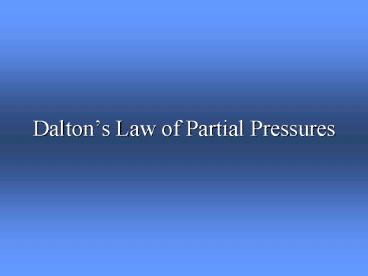Daltons Law of Partial Pressures - PowerPoint PPT Presentation
1 / 7
Title:
Daltons Law of Partial Pressures
Description:
Dalton's Law of Partial Pressures. John ... Dalton's Law of Partial Pressure ... Dalton's Law of Partial Pressures. x. T n. n=1. P = S P. PT = total pressure ... – PowerPoint PPT presentation
Number of Views:97
Avg rating:3.0/5.0
Title: Daltons Law of Partial Pressures
1
Daltons Law of Partial Pressures
2
John Dalton
(1766-1844)
- Proposed the atomic theory in 1808
- Discovered the Law of Multiple Proportions
- Discovered the Law of Partial Pressures
3
Daltons Law of Partial Pressure
The total pressure exerted by a mixture of gases
is equal to the sum of the partial pressures.
The term partial pressure refers to the
pressure exerted by an individual gas in a
mixture of gasesits pressure is part of the
total.
The partial pressure exerted by an individual gas
is not affected by the presence of the other
gasesit depends only on number of moles, volume,
and temperature.
4
Daltons Law of Partial Pressures
- x
- T n
- n1
P S P
PT total pressure x the number of gases
present Pn partial pressure of gas n
For instance, if there are five gases present,
then PT P1 P2 P3 P4 P5
All pressures must be expressed in the same unit.
5
Example 1 A gas canister contains a mixture of
helium at 2.5 atm, neon at 1.75 atm, and xenon.
If the total pressure is 8.0 atm, what is the
partial pressure of the nitrogen?
PHe 2.5 atm
PXe ?
PNe 1.75 atm
PT 8.0 atm
PT P1 P2 P3
(8.0 atm)
(1.75 atm) PXe
(2.5 atm)
8.0 2.5 1.75 PT
PT 3.75 atm
6
Example 2 A gas canister contains 96.0 g oxygen,
112.0 g nitrogen, and 88.0 g carbon dioxide. If
the total pressure in the container is 5.0 atm,
what is the partial pressure of each gas?
nO2 96.0 ? 32.0 3.00 mols
Since they are in the same container, the volume
and temperature are the same, and the pressure is
proportional to the number of moles. Convert each
mass to moles.
nN2 112.0 ? 28.0 4.00 mols
nCO2 88.0 ? 44.0 2.00 mols
PT P1 P2 P3
Since P ? n, then
PT n1X n2X n3X
P1 n1X, P2 n2X, P3 n3X, so
5 atm 3X 4X 2X 9X
5 9X
5 / 9 X
PO2 3X 3(5/9) 2.67 atm
PCO2 2X 2(5/9) 1.11 atm
PN2 4X 4(5/9) 2.22 atm
7
For homework, print out and complete Partial
Pressures Worksheet Practice Problems for this
section Repeat This Lesson Go on to the Next
Lesson Return to Gas Lessons Menu Return to
Main Page































